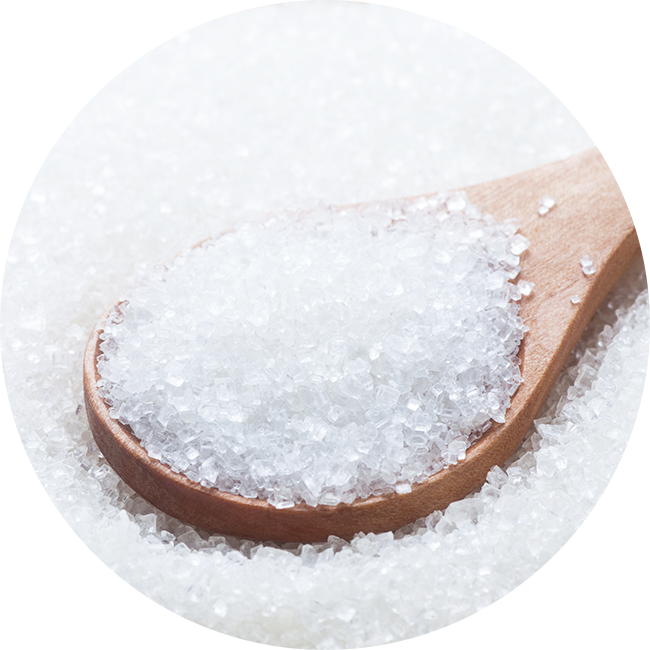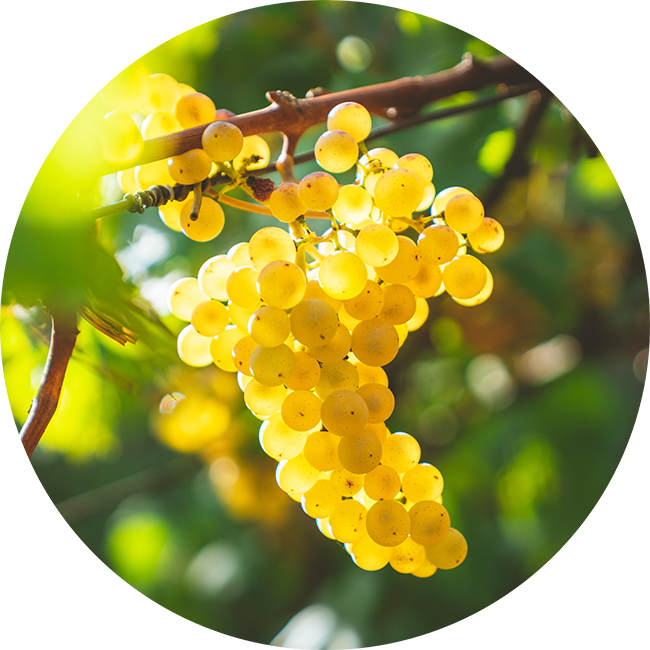WINE
Innovation in a virtuous circle.
That of the grape.
In the wine sector, Naturalia’s Solid Rectified Concentrated Must (MCRS) represents a unique innovation of the highest quality. In fact, the use of MCRS makes it possible to obtain a wine that is 100% made from grapes while maintaining its organoleptic properties unaltered and enhancing its authenticity characteristics.

In the wine industry, Naturalia’s Solid Rectified Concentrated Must (MCRS) represents a unique innovation of the highest quality. The use of MCRS makes it possible to obtain a wine 100% from grapes while maintaining its organoleptic properties and enhancing its authenticity.
Naturalia Ingredients produces and markets Rectified Concentrated Must in the traditional form (liquid) and in the exclusive solid form (MCRS, with the commercial name of crystalMUSTGRAPE or crystalGRAPESUGAR.Bio, in the certified organic version).
These are sugars produced from wine grapes and therefore intended for the wine sector.
The MCRS of Naturalia Ingredients is the only one recognised and approved by Reg. (EU) 1308/2013 for the oenological practices of enrichment, sweetening and sparkling to the same requirements and conditions as for liquid MCR
They are available in conventional form (all NON-GMO certified) and with organic certification, according to EU or USDA-NOP and/or Kosher regulations.


Compared to liquid sugars, crystalline sugars have several advantages:
- lower environmental impact of logistics (-35% of transported volume)
- easy to use
- simplicity of storage
- stability
Sugars in liquid form have several limitations. The presence of water in the product makes it susceptible to microbial pollution, especially by osmosophilic microorganisms, capable of surviving at high sugar concentrations.
In the liquid matrix, the degradation of sugars is favoured, especially at high temperatures, especially fructose, which tends to turn into hydroxymethylfurfural, an undesirable metabolite that causes browning of the product. In addition, as the temperature decreases, the sugars present (particularly glucose, which has a low cold solubility) tend to solidify, forming a crystalline precipitate that requires heat treatment to bring it back into solution before use.
Crystallised sugars, on the other hand, are perfectly stable, so much so that by law they are exempt from the obligation to indicate the Minimum Conservation Period (All. X Reg. (UE) 1169/2011).

MCRS (crystalMUSTGRAPE) is ideal as a substitute for liquid rectified grape must and sucrose in enrichment, sweetening and sparkling processes, as it guarantees the integrity of the wine, chemical and microbiological purity and ease of use
Sugars are very important secondary components used in oenology for must and wine enrichment, sweetening and refermentation. The use of sugars in the main wine-making practices is regulated at European level by specific rules, with different provisions in different countries.
In Italy, as well as in Greece, Spain, Cyprus, Portugal and some French departments, the addition of sucrose is prohibited and enrichment is permitted by adding only concentrated grape must or rectified concentrated grape must. In the case of sparkling wines, the standard requires that dosage syrups and sugar syrups may also include sucrose.
Rectified concentrated grape must (MCR) is a concentrated must that has undergone authorised deacidification treatments and the removal of non-sugar components and is therefore also referred to as “grape sugar”. Traditional MCR is a liquid product with a Brix of no less than 61.7%, consisting mainly of glucose and fructose and in a ratio of approximately 1:1.
However, MCR is not a solution that can equal ordinary crystalline table sugar (sucrose) in terms of purity, stability, logistics and ease of use. In fact, the syrup form has several limitations: the presence of water in the product makes it susceptible to microbial pollution, especially by osmosophilic microorganisms, capable of surviving at high sugar concentrations; at high temperatures the sugars tend to denature (especially fructose), while low temperatures encourage the formation of crystalline precipitates (especially glucose). The product therefore has a limited shelf life, generally reaching 6 months or at most 12 months if packaged aseptically at room temperature.
These limits have recently been overcome with the launch on the international market of MCR in crystallised form or solid rectified concentrated must (MCRS), an innovation 100% made in Italy and unique in the world.
With Implementing Regulation (EU) No. 52/2013 and, subsequently, Regulation (EU) No. 1308/2013 on the organisation of the markets in agricultural products, the European Community recognised the solid form of MCR as comparable to liquid, authorising solid rectified concentrated grape must (MCRS) for oenological practices under the same requirements and conditions as liquid rectified concentrated grape must.
The regulations specify that the product must be obtained without the use of solvents and must have purer characteristics, expressed in particular as sulphur dioxide content, than rectified concentrated grape must in liquid form (10 mg/Kg total sugars in the solid vs. 25 mg/kg total sugars in the liquid).
MCRS, which is also available with organic certification, is in effect a grape sugar of natural origin, for wines made 100% from grapes, with all the advantages of a pure crystalline sugar: it is easy to use, handle and store; it is stable, not susceptible to chemical degradation or microbiological attack; and it is not subject to an expiry or minimum storage date. It can therefore be used without risk even in several successive campaigns.


The Wine4Wine project, conducted by the Edmund Mach Foundation in collaboration with the Wine Research Team, has made it possible to identify the technological advantages of MCRS in comparison with traditional sugars, liquid MCR and sucrose, in the wine-making practices in which they are authorised (enrichment, sweetening and sparkling).
The results of the studies show the presence of numerous volatile compounds in the liquid MCR, which originate both from heating the must during the production process and from the original grapes. These compounds, which are also found in wines to which liquid MCR has been added during enrichment or fermentation, can alter the sensory profile of finished wines, especially in the case of high quality and DOC, DOCG and IGP wines.
In contrast, the analysis of volatile compounds did not lead to the observation of systematically distinctive compounds that would allow sparkling wines produced with MCRS to be distinguished from those produced with sucrose. This confirms that, from a compositional point of view, the MCRS have solved the problem of residual tracer compounds in the MCRS, which historically, and especially in the extra-national sphere, have caused perplexity in the use of sugars of grape origin for sparkling wines. Moreover, unlike liquid MCRS, MCRS are permanently free of microbial contamination that could be harmful to must and wine quality.
In bottle-fermented and Charmat sparkling wines, MCRS guarantee a high organoleptic quality: the resulting sparkling wines are in most cases distinguishable on sensory analysis, with a preference present and expressed in favour of wines produced with the use of MCRS in fermentation, which are considered more pure, fine, harmonious and elegant.
References (in italian):

crystalMUSTGRAPE (and the certified organic version crystalGRAPESUGAR.Bio) is the world’s only EU-authorised solid concentrated must (MCRS) for all winery applications.
Implementing Regulation (EU) No. 52/2013 and, subsequently, Regulation (EU) No. 1308/2013 on the organisation of the markets in agricultural products, introduce the solid form, in addition to the traditional liquid form, of solid rectified concentrated grape must, authorising solid rectified concentrated grape must for oenological practices under the same requirements and conditions as liquid rectified concentrated grape must. The regulations specify that the product must be obtained without the use of solvents and must have purer characteristics, expressed in particular as sulphur dioxide content, than rectified concentrated grape must in liquid form (10 mg/Kg total sugars in the solid vs. 25 mg/kg total sugars in the liquid).
Annex VIII, part I of Reg. (EU) No. 1308/2013 regulates the practice of enrichment at European level.
The Community Oenological Code, Regulation (EU) 934/2019 (which replaced and repealed the previous Reg. (EU) 606/2009) implements the principles on cellar techniques established in the regulation on the Single CMO (Reg. (EU) 1308/2013). In particular:
- Appendix 10 part D of Annex I to Reg. (EU) 2019/934, determines the limits and conditions for the sweetening of wines, which may be carried out using grape must, concentrated grape must and rectified concentrated grape must.
- Annex II to Reg. (EU) 2019/934 defines the authorised oenological practices and restrictions for sparkling wines, quality sparkling wines and quality aromatic sparkling wines, defining dosage syrup and sweetening syrup, the addition of which is not considered an enrichment or sweetening.
Accompanying documents for rectified concentrated grape must, in liquid or solid form, are MVVs (Movment VitiVinicoli). Ministerial Decree no. 293 of 20 March 2015 established the procedures for keeping registers electronically for the wine and food sector to be carried out on the SIAN (Sistema Informativo Agricolo Nazionale – National Agricultural Information System) portal of the MIPAAF (Ministry of Agricultural, Food and Forestry Policies) website. The following shall be entered in the wine register: rectified concentrated must in liquid and solid form, rectified concentrated must in liquid and solid form from organic production, crystalline grape sugars, crystalline grape sugars from organic production, table grape sugars in liquid form.

